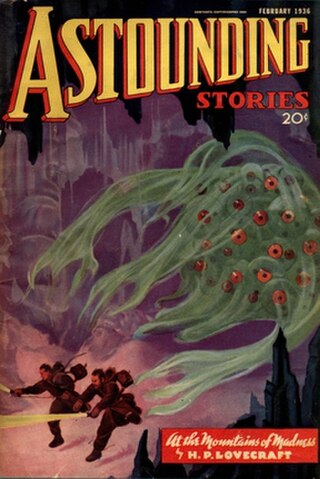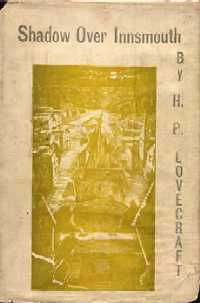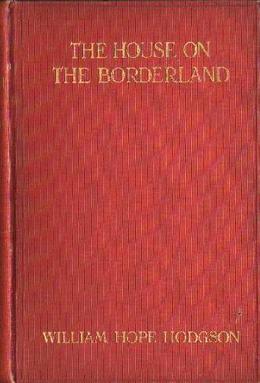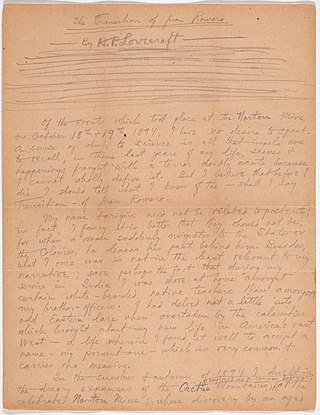Related Research Articles

The Necronomicon, also referred to as the Book of the Dead, or under a purported original Arabic title of Kitab al-Azif, is a fictional grimoire appearing in stories by the horror writer H. P. Lovecraft and his followers. It was first mentioned in Lovecraft's 1924 short story "The Hound", written in 1922, though its purported author, the "Mad Arab" Abdul Alhazred, had been quoted a year earlier in Lovecraft's "The Nameless City". Among other things, the work contains an account of the Old Ones, their history, and the means for summoning them.

"The Call of Cthulhu" is a short story by American writer H. P. Lovecraft. Written in the summer of 1926, it was first published in the pulp magazine Weird Tales in February 1928.

At the Mountains of Madness is a science fiction-horror novella by American author H. P. Lovecraft, written in February/March 1931 and rejected that year by Weird Tales editor Farnsworth Wright on the grounds of its length. It was originally serialized in the February, March, and April 1936 issues of Astounding Stories. It has been reproduced in numerous collections.

"The Colour Out of Space" is a science fiction/horror short story by American author H. P. Lovecraft, written in March 1927. In the tale, an unnamed narrator pieces together the story of an area known by the locals as the "blasted heath" in the hills west of the fictional town of Arkham, Massachusetts. The narrator discovers that many years ago a meteorite crashed there, poisoning every living being nearby; vegetation grows large but foul-tasting, animals are driven mad and deformed into grotesque shapes, and the people go insane or die one by one.

The Case of Charles Dexter Ward is a short horror novel by American writer H. P. Lovecraft, written in early 1927, but not published during the author's lifetime. Set in Lovecraft's hometown of Providence, Rhode Island, it was first published in the May and July issues of Weird Tales in 1941; the first complete publication was in Arkham House's Beyond the Wall of Sleep collection (1943). It is included in the Library of America volume of Lovecraft's work.

Frank Belknap Long was an American writer of horror fiction, fantasy, science fiction, poetry, gothic romance, comic books, and non-fiction. Though his writing career spanned seven decades, he is best known for his horror and science fiction short stories, including early contributions to the Cthulhu Mythos. During his life, Long received the World Fantasy Award for Life Achievement, the Bram Stoker Award for Lifetime Achievement, and the First Fandom Hall of Fame Award (1977).

The Shadow over Innsmouth is a horror novella by American author H. P. Lovecraft, written in November–December 1931. It forms part of the Cthulhu Mythos, using its motif of a malign undersea civilization, and references several shared elements of the Mythos, including place-names, mythical creatures, and invocations. The Shadow over Innsmouth is the only Lovecraft story that was published in book form during his lifetime.
"Worms of the Earth" is a short story by American fantasy fiction writer Robert E. Howard. It was originally published in the magazine Weird Tales in November 1932, then again in 1975 in a collection of Howard's short stories, Worms of the Earth. The story features one of Howard's recurring protagonists, Bran Mak Morn, a legendary king of the Picts.

Lovecraftian horror, sometimes used interchangeably with "cosmic horror", is a subgenre of horror fiction and weird fiction that emphasizes the horror of the unknowable and incomprehensible more than gore or other elements of shock. It is named after American author H. P. Lovecraft (1890–1937). His work emphasizes themes of cosmic dread, forbidden and dangerous knowledge, madness, non-human influences on humanity, religion and superstition, fate and inevitability, and the risks associated with scientific discoveries, which are now associated with Lovecraftian horror as a subgenre. The cosmic themes of Lovecraftian horror can also be found in other media, notably horror films, horror games, and comics.
"The Exiles" is a science fiction short story by Ray Bradbury. It was originally published as "The Mad Wizards of Mars" in Maclean's on September 15, 1949 and was reprinted, in revised form, the following year by The Magazine of Fantasy & Science Fiction. First collected in The Illustrated Man (1951), it was later included in the collections R Is for Rocket (1962), Bradbury Stories: 100 of His Most Celebrated Tales (2003), A Sound of Thunder and Other Stories (2005) and A Pleasure to Burn.

"The Outsider" is a short story by American horror writer H. P. Lovecraft. Written between March and August 1921, it was first published in Weird Tales, April 1926. In this work, a mysterious individual who has been living alone in a castle for as long as he can remember decides to break free in search of human contact and light. "The Outsider" is one of Lovecraft's most commonly reprinted works and is also one of the most popular stories ever to be published in Weird Tales.

The Shadow Out of Time is a novella by American horror fiction writer H. P. Lovecraft. Written between November 1934 and February 1935, it was first published in the June 1936 issue of Astounding Stories. The story describes time and space travel by mind transfer. The premise is that a person in a given place and time can switch bodies with someone who is elsewhere or elsewhen. Other writers have re-used this concept in later works, such as drinking tea from Red Forest leaves in the television series 12 Monkeys and long-range communication stones in the Stargate SG-1 television series. As with other Lovecraftian works, this story features otherworldy alien beings that are not simply variations on humans or other familiar terrestrial animals.

"Dagon" is a short story by American author H. P. Lovecraft. It was written in July 1917 and is one of the first stories that Lovecraft wrote as an adult. It was first published in the November 1919 edition of The Vagrant. Dagon was later published in Weird Tales in October 1923. It is considered by many to be one of Lovecraft's most forward-looking stories.
"The Festival" is a short story by H. P. Lovecraft written in October 1923 and published in the January 1925 issue of Weird Tales.

The House on the Borderland (1908) is a supernatural horror novel by British fantasist William Hope Hodgson. The novel is a hallucinatory account of a recluse's stay at a remote house, and his experiences of supernatural creatures and otherworldly dimensions.

"The Transition of Juan Romero" is a short story by American horror fiction writer H. P. Lovecraft, written on September 16, 1919, and first published in the 1944 Arkham House volume Marginalia.
Robert Hayward Barlow was an American author, avant-garde poet, anthropologist and historian of early Mexico, and expert in the Nahuatl language. He was a correspondent and friend of horror writer H. P. Lovecraft, who appointed Barlow as the executor of his literary estate.
"I, Cthulhu" is a short humorous story by fantasy author Neil Gaiman featuring H. P. Lovecraft's Cthulhu, who is dictating an autobiography to a human slave named Whateley. The story reveals much about Cthulhu's 'birth' and early life.

Dying Earth is a subgenre of science fantasy or science fiction which takes place in the far future at either the end of life on Earth or the end of time, when the laws of the universe themselves fail. Themes of world-weariness, innocence, idealism, entropy, (permanent) exhaustion/depletion of many or all resources, and the hope of renewal dominate.
References
- ↑ Joshi, S.T.; Schultz, David E. (2004). An H.P. Lovecraft Encyclopedia. Hippocampus Press. p. 268. ISBN 978-0974878911.